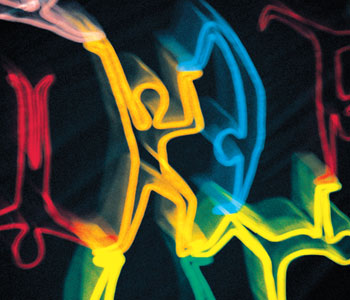Light Touch
Playing With Light
A history of Games that incorporate the photon.

The December 1941 issue of Astounding Science Fiction magazine contained a short story titled “Bullard Reflects,” which describes a game called Dazzle Dart. Each team’s “quarterback” has a “superflashlight” equipped to produce 100 flashes of light, each of which is 10 seconds long. The other team members have slightly concave mirrors attached to their arms and legs. The object is to bounce the 1-cm-diameter beam from flashlight to mirror to mirror and eventually into the team’s goal. Opposing team members can block the beam, or try to redirect it into their own goal. That the game is played in the lower gravity of the moon adds to the strategic possibilities.
The story, written by Malcolm Jameson, is the fourth in a series about Captain Bullard of the spaceship Pollux, part of the Space Patrol that kept order throughout the Solar System. The game takes place between the Polliwogs of the Pollux and the Castor Beans of the sister ship Castor.
Jameson’s game is well thought out. The 10-s burst gives players time to redirect the beam without having to anticipate the conditions. The slightly concave mirrors counteract the beam spread. The only major change one might make would be to substitute a laser—an option not available in 1941. But the game never caught on among science fiction fans, who have been known to recreate fictional games such as Edgar Rice Burroughs’ Martian Chess, Jetan.
Why not? Certainly the technology existed. Indeed, it may have been possible to play games with light beams as far back as ancient Egypt, where some have theorized that polished metal mirrors were used to relay sunlight into tombs. (Whether that’s true or not, I’ll bet someone used a mirror to beguile his cat the same way I do mine with my laser pointer.) Yet, throughout history, there have been few games in which light plays an essential part.
The end of the 19th century would have been the ideal time for such games. The electric light had been invented, and was made portable by batteries and generators before the end of the century. In addition, the selenium photocell was used by Alexander Graham Bell to transmit phone signals on light beams.
The first light games I could find appeared in 1935 by the Rayolite Company, which was founded in Tulsa, Okla. In April of that year, Charles W. Griffith filed a patent for a game using mechanical and optical elements. A device shaped like a rifle fired a light beam at a target that bore a corner cube reflector. The “rifle” barrel also hosted a photocell detector that registered a voltage when the light reflected from the corner cube back in the barrel.
The patent was granted on July 2, 1936, and advertisements appeared immediately. Games were placed in the same places where pinball machines, and, later, video games would appear—in bars, small restaurants and arcades. The games were manufactured by the J.P. Seeburg Corporation of Chicago, and sold for $495 a piece. It cost five cents for 10-20 shots at a moving target.
The game was popular, and a series of new patents supported many variations. Eventually, players had the option of shooting at ducks, bears, raccoons, jailbreakers and WWII war targets. Other companies soon deduced how to build light games without infringing on the Rayolite patents. These games continued to be produced until video games were widely substituted for mechanical ones.
With cathode ray tubes as displays, the guns no longer had to provide their own light source, but could simply detect light from the tube itself. Originally they could detect which target was being pointed at by temporally correlating the applied signal with the detected one. Current plasma and LCD displays use more refined detection schemes.
The next step in the evolution of light games was taken when the U.S. Army contracted for the development of MILES—the Multiple Integrated Laser Engagement System—in the 1970s. This system for simulated warfare used a laser module attached to an actual gun barrel. When the gun fired a blank cartridge, the laser fired a coded burst that could be received by a sensor worn by the opponent, and would register a hit only if the shooter was, indeed, on target.
The system has continued in use, and was upgraded in the 1990s. A related system, the Engagement Simulation System (ESS), was used by the Department of Energy to train police forces that guard nuclear power plants. The MILES system helped to inspire civilian counterparts.
For example, in 1979, coincident with the release of Star Trek: The Motion Picture, South Bend Toys of Indiana produced Star Trek Electronic Phaser Guns. These used infrared sources and detectors, and registered hits from other guns with “phaser” noises. Five years later, George Carter III of Texas produced Photon, a game he conceived of while watching Star Wars in 1977. He set up an arena for teams equipped with light guns and receivers to fight it out with each other. The first Photon center opened in Dallas in March 1984. A franchise opened in Toronto the following year.
A year later, Worlds of Wonder produced Lazer Tag, which used a similar format. Within a short time, there were many imitators. The market for these games slowed in the early 1990s, but has recently regained force.
From Rayolite onward, these games were all simple shooter games, with photons substituting for solid bullets. There was nothing more exotic than a simple direct line from source to target, with no ricochet or reflection involved. Intriguingly, something closer to Jameson’s vision did eventually appear in the virtual world.
Log in or become a member to view the full text of this article.
This article may be available for purchase via the search at Optica Publishing Group.
Optica Members get the full text of Optics & Photonics News, plus a variety of other member benefits.
